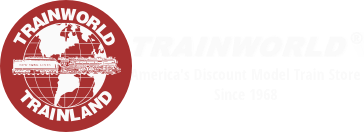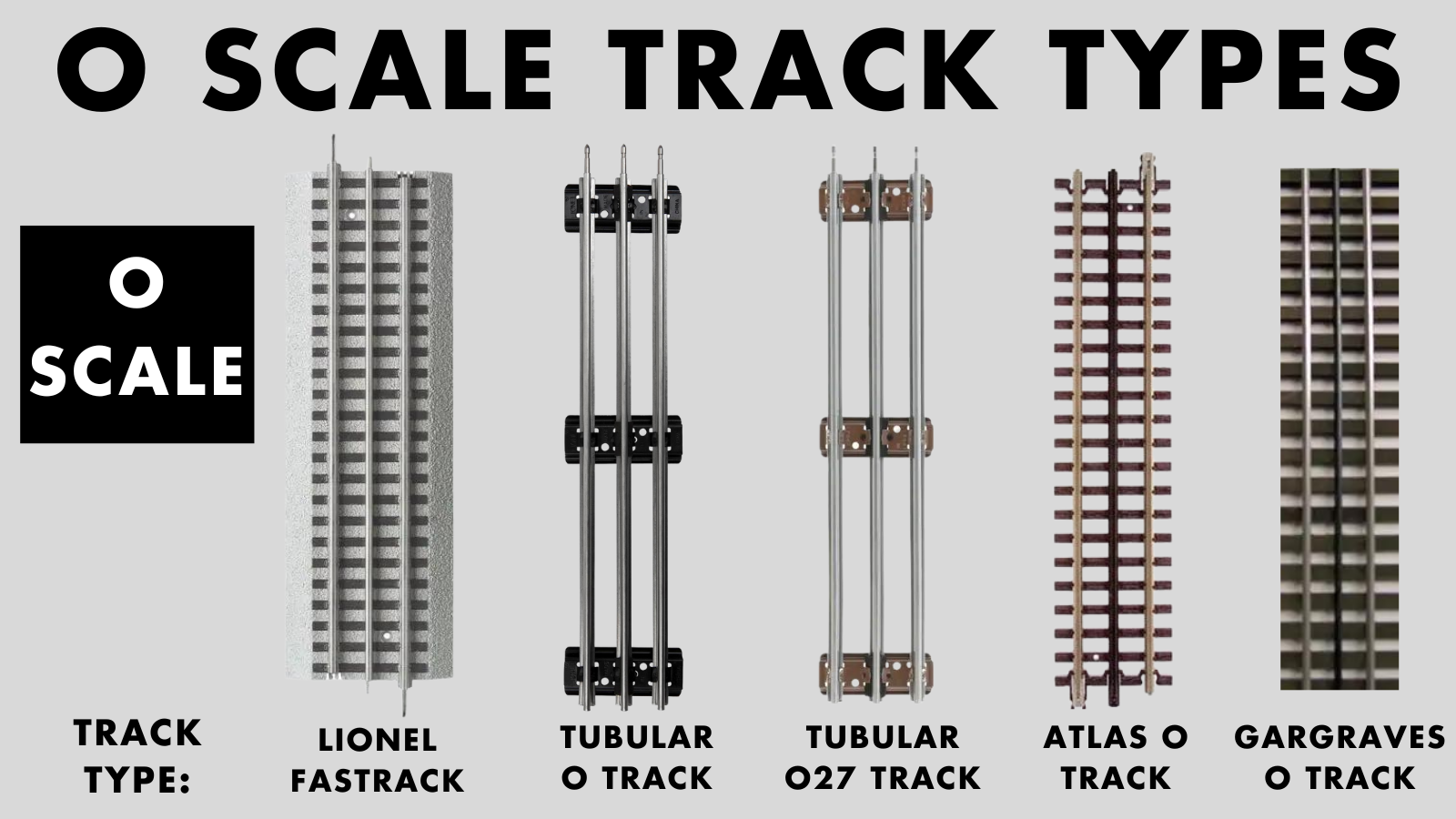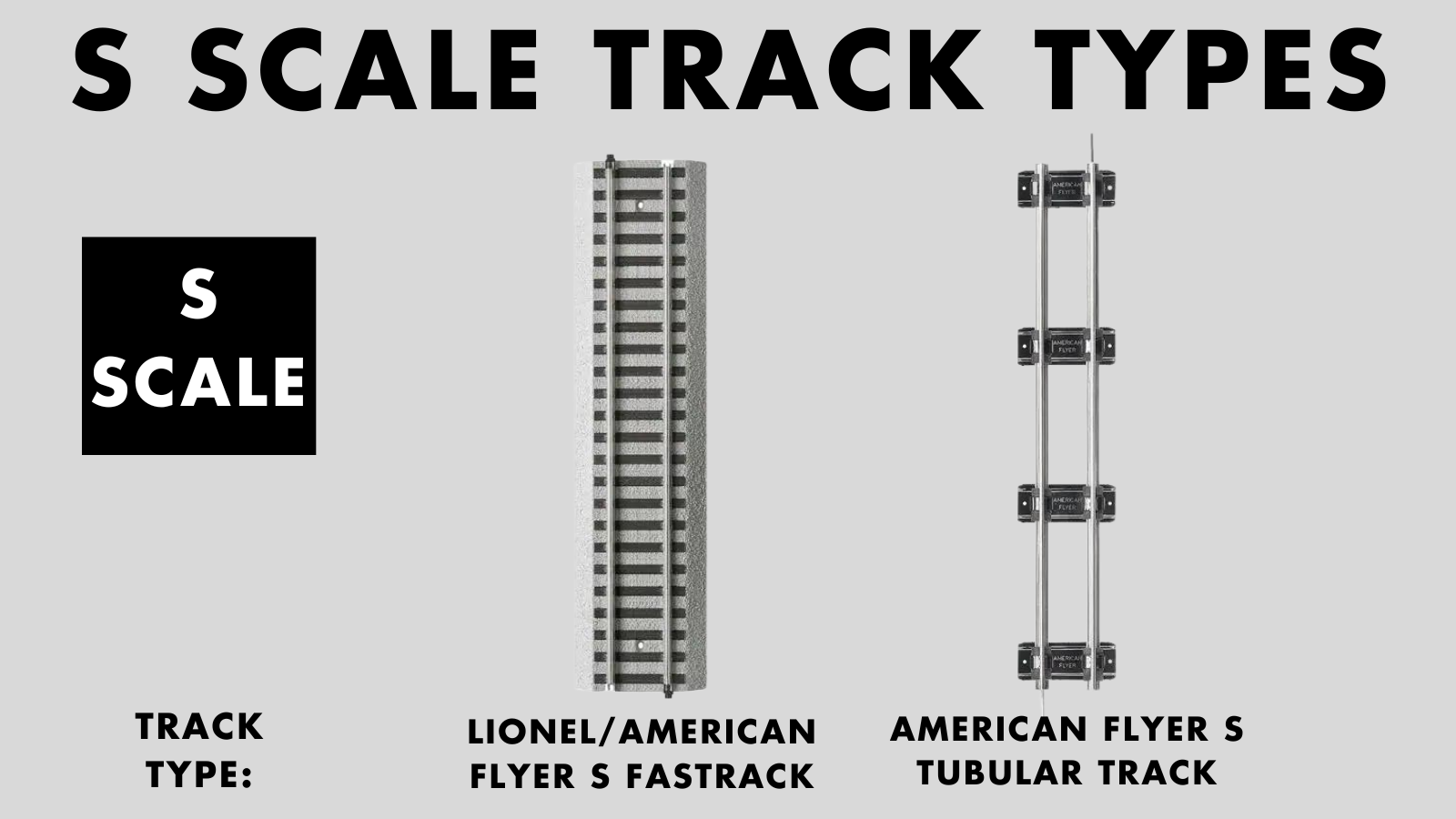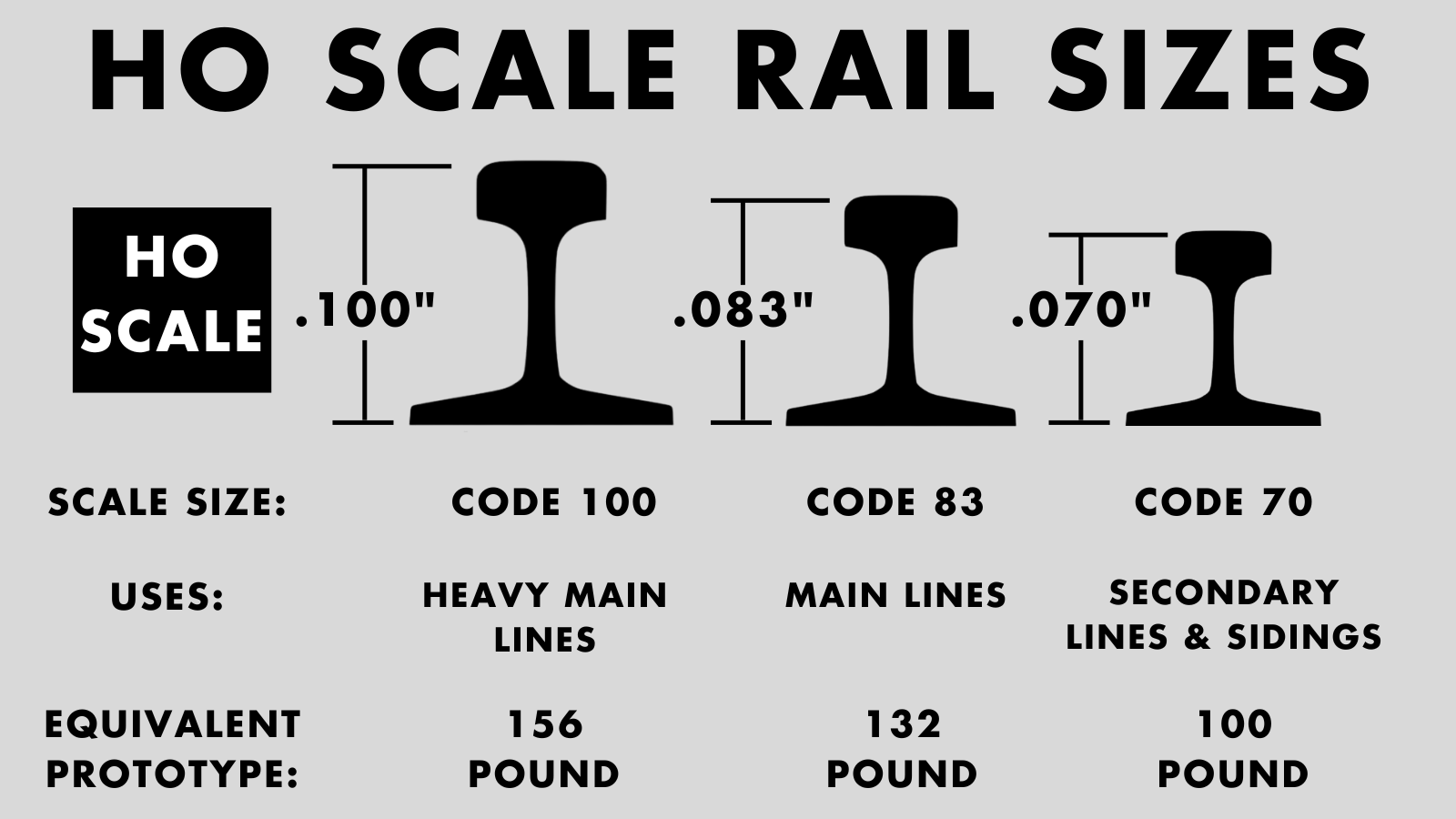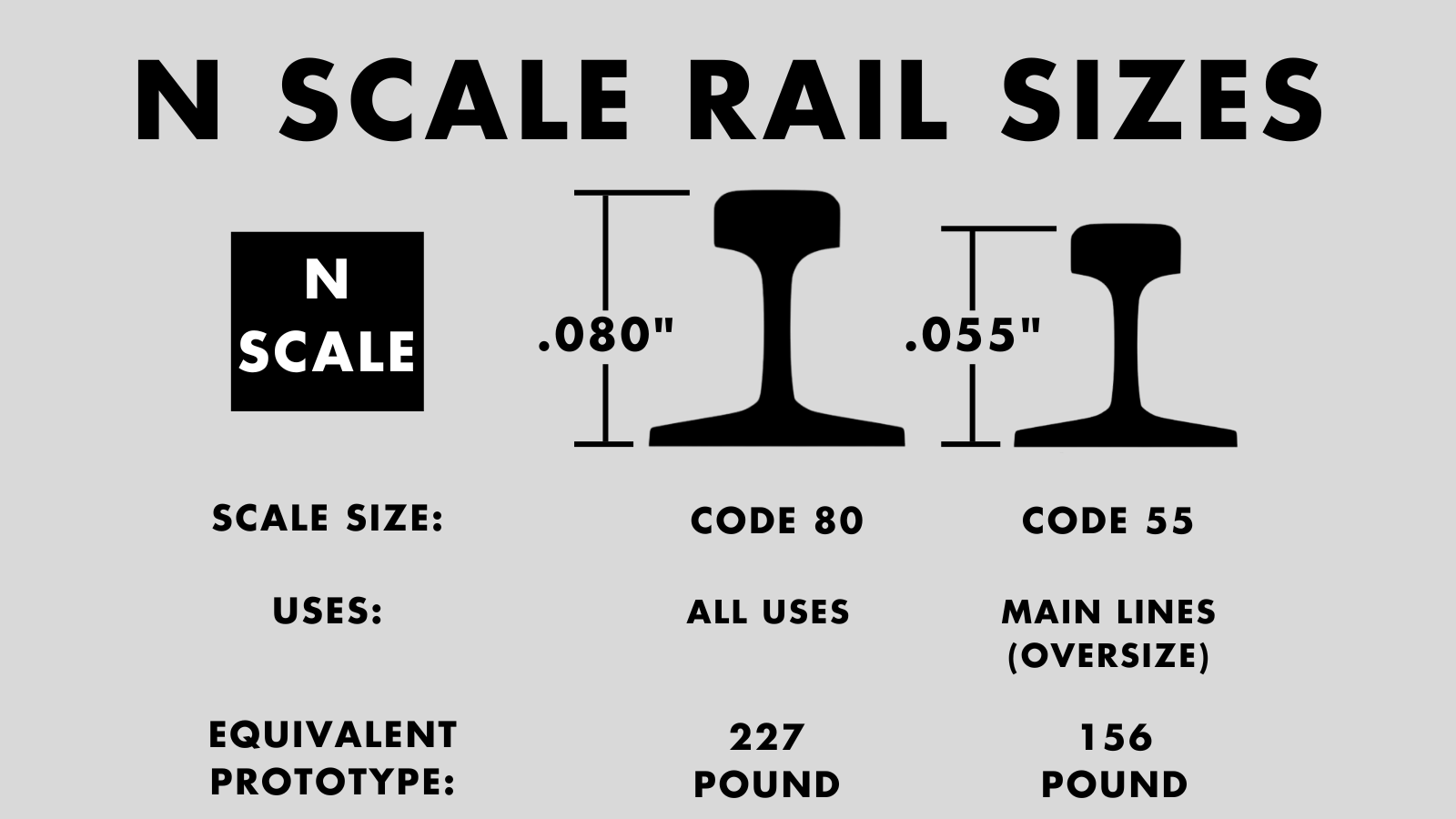Train Track 101
Helpful Guide To All Your Model Train Track Needs:
Why Do You Need To Choose The Right Track For Your Model Trains?
Choosing the right type of Track for your model railroad is among the most important things you will need to consider, especially when you are still new to the hobby. Of course, matching the size of the track to the model is important (HO Scale models will certainly not run on O Scale track), however, there are many other considerations to keep in mind as well. Will you be dedicating a whole room in your house or a certain amount of space (such as a table) over to a permanent layout? Do you simply want to set up your trains periodically (such as around the Christmas tree during the Holidays) and store them the rest of the time? Do you want to run Freight or Passenger equipment? etc. Below we will help you weigh these considerations (and more!) to find the right type of Track for you! We will outline the different types of Track and go over some of the basic information for each Scale from largest to smallest
A Quick Note On Scale VS Gauge:
The words ‘Scale’ and ‘Gauge’ are commonly used by hobbyists and retailers interchangeably, however there is technically a difference between the two. ‘Scale’ describes the size of a miniature (let’s say a model locomotive) in proportion to its full-size prototype (the actual, real-life locomotive). For example, in O Scale every inch of the model represents 48 inches of the prototype, or real life object. Put another way, O Scale models are 48 times smaller than their real life counterpart, or prototype. This relationship is commonly noted as 1:48. It follows then that HO Scale (which is an abbreviation for Half O) models are 1:87, or roughly half the size of O Scale models. ‘Gauge’ on the other hand, simply refers to the distance between the rails of the Track. The terms ‘Scale’ and ‘Gauge’ are often used interchangeably on our website, as they are amongst our Customers and in most of the model railroad community.
Types Of Model Train Track (General):
While there are many different brands, styles and kinds of Track sections available across all of the different Scales in model railroading, there are really only two types of Track generally speaking – Track which includes a simulated Roadbed and Track that does not include a simulated Roadbed. Track which includes a simulated Roadbed is sometimes called Integrated Track, but it most often also has a proprietary brand name (such as Bachmann’s E-Z Track, Lionel’s FasTrack, etc.) respective to the manufacturer. It is easy to tell the two apart, as the Track without Roadbed simply consists of the rails and track ties, while the Roadbed Track (or Integrated Track) also has a plastic base which is molded to simulate ballast, the rocky material used for the track bed on real railroads. From here on, we will refer to the Track which includes a simulated Roadbed as ‘Roadbed Track’ and the Track which does not have a simulated Roadbed as ‘Traditional Track’. ‘Roadbed Track’ and ‘Traditional Track’ each have their own advantages and disadvantages, so we will give a general outline of each so you can decide what’s right for you! Most Starter Sets come with ‘Roadbed Track’. There are a few exceptions, but the vast majority of Starter Sets from American Flyer, Bachmann, Kato, and Lionel include ‘Roadbed Track’. In other words, most O Scale, HO Scale and N Scale Starter Sets come with ‘Roadbed Track’. G Scale is a different story – all of the G Scale Starter Sets come with ‘Traditional Track’, as there is no ‘Roadbed Track’ available in G Scale to date. Z Scale is also mainly ‘Traditional Track’, although there have been some ‘Roadbed Track’ options for Z Scale which have just recently become available. This is all to say that if you are planning on beginning with a Starter Set, you may just want to expand upon it further with the same type of Track that comes with Set initially – after all, why purchase a complete Starter Set to NOT use the Tracks that come with it?! Some of the advantages of ‘Roadbed Track’ are as follows – it does not need to be permanently affixed to a surface and will hold together securely when assembled. It is easy to connect and take apart. The molded plastic base (the ‘Roadbed’) provides a firm, flat support which is ideal for temporary layouts, and can also be used on many types of carpeting – the ‘Roadbed’ elevates the track sufficiently up and away from the carpet fibers in most cases. Some disadvantages are as follows – the most common complaint from modelers about ‘Roadbed Track’ is that it does not look realistic. Another issue is that each type of ‘Roadbed Track’ has its own unique locking tab, making it incompatible with ‘Roadbed Tracks’ from other manufacturers – for example, Kato’s HO UniTrack will not mate with Bachmann’s HO E-Z Track without considerable modification. Some of the advantages of ‘Traditional Track’ are as follows – it looks more realistic and allows the modeler to choose their preferred size and color of ballast or forgo ballast altogether. ‘Traditional Track’ is almost always used on more ‘serious’ or ‘museum quality’ layouts. In most cases, ‘Traditional Track’ is compatible between manufacturers provided the Code is the same (this will be discussed further below). ‘Traditional Track’ has also been around a lot longer – this may become important if you are planning on running older (1990’s and before) Locomotives and/or Rolling Stock (this is discussed further in the section on Code below), want to expand upon an older layout, or simply like the ‘traditional’ look of things! Some disadvantages of ‘Traditional Track’ are as follows – it needs to be permanently affixed to a surface via Track Nails. It requires a bit more dexterity to assemble, join, and work with in general. It is not recommended for use on carpets or floors, except in the case of G Scale. In short, it looks a lot more realistic but also requires considerably more effort on the modeler’s part! Most of the manufacturers that produce ‘Roadbed Track’ will also make a track section (usually a Straight) that allows the modeler to transition from ‘Roadbed Track’ to ‘Traditional Track’. Examples of this would be Lionel #6-12040 which allows a transition from FasTrack to Traditional Tubular Track, or Kato #20-045 which allows a transition from Kato UniTrack to Traditional Code 80 Track.
What Is Track Code And Why Is It Important?
‘Code’, as it relates to Track, refers to the height (or profile) of the rail itself. Track Codes are set by the NMRA, and measure the height of the rail in thousandths of an inch – for example, the rail on N Scale Code 55 Track is 0.055” high. Many manufacturers offer several different Codes across one Scale – for example, Atlas makes HO Track in Code 100 or Code 83. This is an effort by the manufacturers to be more prototypical – Code 83 is closer to the true height of the prototype than Code 100, which is technically a bit tall. Code 100 has been around a lot longer than Code 83, and many models produced in the 1990’s and before have larger wheel flanges which are fine for Code 100 but sometimes have issues running on Code 83 since it has a lower profile. The same holds true in N Scale – Code 80 has been around much longer than Code 55, but Code 55 is a lot closer to what the true height of the rail should be in N Scale. Many older N Scale models will have large wheel flanges that run fine on Code 80, but bounce around on Code 55 due to the lower rail profile. The issue with larger wheel flanges running on lower profile rails can usually be resolved by switching out the truck and wheelsets, but it is a good thing to be aware of if you plan on mixing older and contemporary equipment. That issue aside, most real railroads use different sizes of rail on mainlines, spurs, yards, etc. which makes the different Codes attractive for those that want to be as prototypically accurate as possible! Connecting rails with different Codes is possible, but will require a special Rail Joiner, called a ‘Transition Joiner’.
Check Out Our How Many Curves In A Circle Of Track Guide Below:
Track Planning (General):
You can always check the link above if you just want to make a basic circle of Track, and it seems obvious that you can turn the circle into an oval by adding equal amounts of Straight Track to each side, but what if you want to build a more complicated layout? Many people simply purchase a bunch of Track and then see what they can come up with, but this approach runs the risk of purchasing unnecessary or superfluous track sections. There are many resources for Track Planning available, not the least of which are Books! There are a few Track-specific Books, such as Lionel’s ‘The FasTrack Book’ (which includes several Track Plans using Lionel FasTrack) or Bachmann’s ‘E-Z Model Railraods’ (which includes several Track Plans using Bachmann’s E-Z Track) but they aren’t always easy to find. There are several more general Track Planning titles available from Kalmbach, each containing many different Scale-specific track plans using ‘Traditional Track’ (i.e. Track without Roadbed), but again they can be hard to find or may contain outdated track sections that are no longer being produced. There are also many examples of Track Plans that modelers have posted in the various model railroading forums online, but the most helpful innovation in recent years has been the proliferation of Track Planning Software that is available for download online. Some of these programs are available for purchase, while others are free to download and use. Some examples include AnyRail, XTrkCAD and RailModelerPro.The most often used and most widely cited program is SCARM, which stands for ‘Simple Computer Aided Railway Modeler’, a free program that includes the majority of track types, Scales and Codes from different manufacturers. These type of programs make Track Planning a lot easier for those of us who didn’t do so well in Geometry class, and will let you know when something isn’t working and takes the guesswork out of planning your layout!
Link To SCARM:
Minimum Turning Radius - What Is It And Why Is It Important?
Another important thing to keep in mind when planning your layout is the ‘Minimum Turning Radius’ that is required for the models you want to run. This is the sharpest Curve any given item will be able to negotiate. In other words, the longer a Locomotive or piece of Rolling Stock is the wider the Curved Track section will have to be for the item to successfully navigate the Curve without de-railing. For example, Passenger Cars (generally speaking) require a wider, or more gradual, turning radius (Curve) than a typical Freight Car. In HO Scale, for example, a 40’ Freight Car will typically have a Minimum Turning Radius of 18” or greater, while a typical HO Passenger Car will usually require a Minimum Turning Radius of 22”, or even 24” or greater. This is not only due to the overall length of the Car, but also to the amount of space between the truck and wheelsets, the number of wheels on each truck, etc. Provided the Curved Track sections on your layout meet the Minimum Turning Radius that is listed (or are larger than the Minimum) for any given item you will be able to run the item on your layout. Let’s take an example in O Scale – let’s say an item has a Minimum Turning Radius of O36. This model will operate on O36, O48, O60, O72 and so on all the up – the model WILL NOT be able to run on O31 or O27 Curves. Most manufacturers will provide the Minimum Turning Radius for every model they produce somewhere in the product listing, but if you are ever unsure of an item’s Minimum Turning Radius you can always send us an email inquiry and we will be happy to confirm for you! A final note on Minimum Turning Radius – real railroads tend to use extremely gradual curves, and a model of any Scale will ALWAYS look a lot more realistic operating over a wider, or more gradual, Curve. It is always advisable to go as wide as you can with your Curved Track sections, as this will not only look more realistic to the eye but will also give you the opportunity to run longer Locomotives and Rolling Stock in the future should you choose to.
Track Overview By Scale:
G Scale
Here at TrainWorld, we carry G Scale Track sections from LGB, Piko & Bachmann. Most of the G Scale Track sections feature brass rail and plastic ties. Bachmann also makes a line of G Scale Track with stainless steel rail and plastic ties.
G Scale Track with a brass rail is suitable for indoor & outdoor use and can remain outdoors in all types of weather. G Scale Track with stainless steel rails are for indoor use ONLY.
The Gauge of G Scale Track is 45mm, or 1.75 inches between the rails. This gauge is convenient for operating a wide variety of models from 1:22.5 thru 1:32 scale.
Shop For G Scale Track Below:


Tinplate - Standard Gauge
These models were initially produced in the 1920’s-30’s, and experienced a small revival in the 1990’s-2000’s with offerings by Lionel and M.T.H. The common track used was the 3 Rail Tinplate Standard Gauge Track, which is now very hard to come by and is no longer readily available from any manufacturer. Despite it’s scarcity, the 3 Rail Tinplate Standard Gauge Track is the best Track to use for this Scale.
Shop For Tinplate Track Below:
O Scale
3-Rail O Gauge Track is consistently produced by and readily available from three manufacturers - Lionel, Atlas & Gargraves. MTH also makes a line of 3-Rail O Gauge Track (RealTrax), but it hasn’t been readily available from the manufacturer for several years now.
Lionel’s current Track System is called Lionel FasTrack. This is the type of Track that is included in Lionel’s Starter Sets, and it has a plastic simulated Roadbed base which allows it to be used for temporary or portable layouts, including just setting it up on the floor! This is probably our most popular O Gauge Track System, and it looks realistic enough that many of our more discerning Customers use it on their permanent layouts! The FasTrack does not need to be permanently affixed to a surface but does have pilot holes for Track Nails/Screws should the Customer choose to secure it in a permanent fashion.
TrainWorld also has Traditional Tinplate O Gauge Tubular Track – this is Lionel’s older Track System which does not have a simulated Roadbed, it simply consists of the rails and track ties. It is primarily used for O Gauge Pre-War and Post-War Lionel Trains and should be permanently affixed to a surface. Traditional Tinplate O Gauge Tubular Track was produced for many years in both O Gauge (black metal ties) & O27 Gauge (brown metal ties) but has since been discontinued by the manufacturer and is becoming harder and harder to find!
Both Atlas & GarGraves Track Systems are ‘Traditional’ in the sense that they do not have a simulated plastic Roadbed. Atlas & GarGraves are specifically designed for permanent layouts, and both systems need to be permanently affixed to a surface via Track Nails/Screws. Gargraves Track sections feature realistic wooden ties!
Check Out Our Lionel FasTrack Guide Below:
Shop For O Scale Track Below:
S Scale
S Scale models can be run on either 2-Rail S Gauge Traditional Tinplate Track or Lionel/American Flyer 2-Rail S Gauge FasTrack. The Traditional 2-Rail S Gauge Tinplate Track needs to be permanently affixed to a surface, while the Lionel/American Flyer 2-Rail S Gauge FasTrack does not.
Shop For S Scale Track Below:
On30 Scale
On30 Scale is used to model a narrow-gauge railroad in O Scale. They are essentially an O Scale (1:48) model that has a narrower wheel base which runs on HO Track. Examples of narrow-gauge railroads include logging and/or mining operations, tourist excursion trains, etc.
Bachmann’s On30 Starter Sets come with either black (most common) or grey HO Scale E-Z Track. All of Bachmann’s HO Scale E-Z Track is Code 100, whether black or grey, and can be mated with each other. The main difference between the two, other than the color of the Roadbed, is the composite metal which makes up the rail. The Black E-Z Track uses Steel Alloy for the rail while the Grey E-Z Track uses Nickel Silver. The Nickel Silver rail tends to require less cleaning and maintenance, and also conducts electricity better than the Steel Alloy. That being said, the Steel Alloy Track is less expensive – an important consideration if you are on a budget. Both versions of E-Z Track can be used for temporary or permanent layouts.
Kato HO Scale Unitrack is Code 83 Track with a Nickel Silver rail. The variation in color of the simulated ballast Roadbed is particularly eye-catching, and the Track is very reliable. Good for permanent or nonpermanent layouts, does not need to be permanently affixed.
Atlas, Peco & Walthers tracks are available in Nickel Silver Code 100 & Code 83. Must be permanently affixed to a surface.
Micro Engineering is available in Nickel Silver Code 100, Code 83 & Code 70. Must be permanently affixed to a surface. The manufacturer notes the Track has a "lower profile" rail therefore it may require some modifications to match other brands of the track "even if considered the same code".
Shop For ON30 Scale Track Below:
HO Scale
Bachmann starter sets come with either black (most common) or grey HO EZ Track. All HO EZ Track is Code 100.
Black HO EZ Track - Steel Alloy & Grey HO EZ Track - Nickel Silver
HO EZ Track has a roadbed that can be permanently mounted or assembled & disassembled as needed. The Grey HO EZ Track (Nickel Silver) is better as it provides better electrical as it stays cleaner.
Kato HO Unitrack is Nickel Silver Code 83 Track. Good for permanent or nonpermanent layouts.
Atlas, Peco & Walthers tracks are available in Nickel Silver Code 100 & Code 83. Must be permanently affixed to a table.
Micro Engineering is available in Nickel Silver Code 100, Code 83 & Code 70. Must be permanently affixed to a table. Has a "lower profile" rail therefore it may require some modifications to match other brands of the track "even if considered the same code".
Shop For HO Scale Track Below:
N Scale
N Scale Track comes in either Code 80 or Code 55. Code 80 is the most popular for N Scale as it has been around longer, but is less prototypical than Code 55. In addition, some models made before the advent of Code 55 may have trouble running on Code 55 due to the combination of larger wheel flanges and a lower profile rail.
Bachmanns N Scale Starter Sets come with N Scale Code 80 Nickel Silver E-Z Track (With Roadbed).
Kato’s N Scale Starter Sets come with N Scale Code 80 Nickel Silver UniTrack (With Roadbed).
The Bachmann E-Z Track System and Kato UniTrak System are both ‘Roadbed Track’. For ‘Traditional’ N Scale Track sections without a Roadbed we stock Peco & Atlas Track sections, which are available in Code 80 & Code 55. The ‘Traditional Track’ section by Peco and Atlas need to be permanently affixed to a surface via Track Nails.
Shop For N Scale Track Below:
Z Scale
The best Z Scale Track System is Marklin’s Z Track. This is a ‘Traditional Track’ system in the sense that it does not have a simulated Roadbed and needs to be permanently affixed to a surface via Track Nails. Marklin Z Scale Track will accommodate any manufacturer’s Z Scale models.
Shop For Z Scale Track Below:
